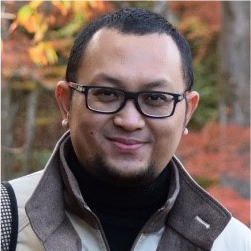Researcher Directory

Hanggara Sudrajat, Ph.D., is a researcher and member of the Quantum Materials research group. He received his doctoral degree from Thammasat University, Thailand, in 2016, where he received the Best Doctoral Thesis Award in Science and Technology. His research investigates the fundamental science of high-performance catalysts for artificial photosynthesis and the photo-biorefinery of industrially relevant reactions. To achieve this, he employs synchrotron-based techniques such as X-ray absorption spectroscopy and X-ray fluorescence holography to study atomic structures in two and three dimensions; spectroscopic methods for probing charge-carrier behavior, such as time-resolved microwave conductivity and transient absorption spectroscopy; and other advanced analytical tools such as ultra-high-resolution scanning transmission electron microscopy. At present, his work focuses on exploring topological quantum materials and carbon-based materials for heterogeneous catalysis.
- Research Keywords: Photocatalysts, Artificial Photosynthesis, Renewable Energy, Fine Chemicals.
- Contact: hanggara.sudrajat(at)brin.go.id
- Metrics: Google Scholar, Scopus
- Ph.D. (2016) | Chemical Engineering Program, Sirindhorn International Institute of Technology, Thammasat University, Thailand.
- M.Eng. (2011) | Department of Chemical Engineering, Universitas Gadjah Mada, Indonesia.
- S.Si. / B.Sc. (2008) | Department of Chemistry, Universitas Gadjah Mada, Indonesia.
- 2022–present, Researcher, BRIN Research Center for Quantum Physics, Indonesia.
- 2023–2025, NAWA Postdoctoral Fellow, Institute of Physical Chemistry, Polish Academy of Sciences, Poland
- 2020, Visiting Researcher, Department of Applied Physics, TU Eindhoven, the Netherlands.
- 2019, Visiting Researcher, Institute of Functional Interfaces, Karlsruher Institut für Technologie, Germany.
- 2018–2020, JSPS Postdoctoral Fellow, Department of Chemistry, Kobe University, Japan.
- 2016–2021, Assistant Professor, Division of Computational Physics, Ton Duc Thang University, Vietnam.
- 2014–2015, Visiting Researcher, Department of Urban Engineering, University of Tokyo, Japan.
- H. Sudrajat, “Topological quantum materials in catalysis”, J. Mater. Chem. A 13, 6325 (2025).
- H. Sudrajat, J. Phanthuwongpakdee, and J. C. Colmenares, “Simple defect engineering of carbon nitride using mixed precursors for enhanced photocatalysis”, Chem. Commun. 61, 7664-7667 (2025).
- H. Sudrajat, S. A. Wella, J. Phanthuwongpakdee, D. Lisovytskiy, K. Sobczak and J. C. Colmenares, “Atomistic understanding of enhanced selectivity in photocatalytic oxidation of benzyl alcohol to benzaldehyde using graphitic carbon nitride loaded with single copper atoms”, Nanoscale (2024).
- H. Sudrajat, I. Carra, I. Rossetti, R. Schneider, and J. C. Colmenares, “Probing Charge Carrier Behavior in Engineered Photocatalysts with Time-Resolved Visible to Mid-IR Absorption Spectroscopy”, J. Phys. Chem. C 127, 45, 21881 (2023).
- H. Sudrajat, S. Hartuti, and S. Babel, “Mechanistic understanding of the increased photoactivity of TiO2 nanosheets upon tantalum doping”, Phys. Chem. Chem. Phys. 24, 995 (2022).
- H. Sudrajat, M. Kitta, R. Katoh, N. Ichikuni, and H. Onishi, “Dependence of Photoexcited Electron Behavior on Octahedral Distortion in Barium-Doped NaTaO3 Photocatalysts”, J. Phys. Chem. C 125, 16403 (2021).
- H. Sudrajat, M. Kitta, R. Ito, T. Yoshida, R. Katoh, B. Ohtani, N. Ichikuni, and H. Onishi, “The role of the shell in core–shell-structured La-doped NaTaO3 photocatalysts”, Phys. Chem. Chem. Phys. 23, 8868 (2021).
- H. Sudrajat, M. Kitta, R. Ito, S. Nagai, T. Yoshida, R. Katoh, B. Ohtani, N. Ichikuni, and H. Onishi, “Water-Splitting Activity of La-Doped NaTaO3 Photocatalysts Sensitive to Spatial Distribution of Dopants”, J. Phys. Chem. C 124, 15285 (2020).
- H. Sudrajat, M. M. Fadlallah, S. Tao, M. Kitta, N. Ichikuni, and H. Onishi, “Dopant site in indium-doped SrTiO3 photocatalysts”, Phys. Chem. Chem. Phys. 22, 19178 (2020).
- H. Sudrajat, D. Dhakal, M. Kitta, T. Sasaki, A. Ozawa, S. Babel, T. Yoshida, N. Ichikuni, and H. Onishi, “Electron Population and Water Splitting Activity Controlled by Strontium Cations Doped in KTaO3 Photocatalysts”, J. Phys. Chem. C 123, 18387 (2019).